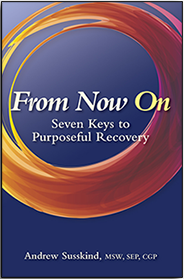Sexual compulsives compartmentalize sex and intimacy as separate experiences, so the quest to integrate them may seem like a long haul. Similar to how a drug addict chooses to abstain from their substance of choice, you’ve chosen to give up the adrenaline rush and immediate gratification that accompanied risky behaviors like anonymous sex or visits to “happy ending” massage parlors. If you can maintain sexual sobriety, an open heart, and some perseverance, all the rewards of emotional sobriety may come your way too.
Which is not to say the process is easy. Compulsive sex was likely a secretive part of you. To share it with others is scary, yet also a powerful way to be more transparent and courageous. One of the challenges over time is to integrate both the shadow and the light within you. It felt shameful and deceptive to engage in socially unacceptable behavior. On the other hand, at times it was playful and exciting. Bringing these sides of you together and into the light, slowly and respectfully—accepting and understanding all parts of yourself—is an essential part of long-term healing.
This usually happens with a therapist or a sponsor, and ultimately results in you feeling fully seen and heard, without compartmentalizing. The sexual risks and secrecy of your past can be replaced with emotional risks and vulnerability from now on. All it takes is the daily intention of willingness, transparency, and courage. Love and intimacy is not just a concept—it’s a practice. You may still want to regulate the emotional distance between yourself and others, but you’ll always be wired for connection as well, and therein lies the dilemma.
Once you begin to face your avoidant style, you’ll feel awkward and discouraged at first, but over time you’ll get to experience the dividends of deeper connection. Aware of the contributors to your pain—grief, shame, self-centeredness, and a lack of boundaries—you’ll finally see these tendencies for what they are—ways of shielding yourself that have outlasted their purpose.
Alex illustrates this internal shift as follows:
In recovery I got to see things about myself that I’d never seen, like when I want to act out, when I don’t, how much I push people away, and how I cling to people. I was so self-absorbed…I decided to change careers to be of service to others.
One of the most gratifying parts of my practice is witnessing clients go from being unconscious to conscious. When we first meet, they know they are in pain but aren’t sure why. As we work together to shine a light on past patterns, they come to understand themselves, and feel freedom and relief as a result. When past triggers become less powerful, the here and now becomes a more tolerable and even pleasant place to be. At last, you feel more comfortable in your skin.




